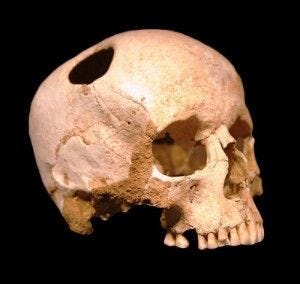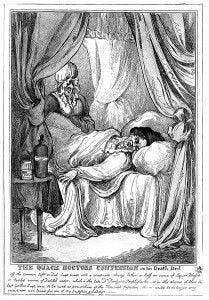Without much concrete medical knowledge, doctors in history developed a lot of rather creative and misguided treatments to heal their patients. Most of these remedies were ineffective, and several of them are downright disgusting! Check out some of the most unsettling treatments of old and be thankful that we live in this century...
- Trepanation
Simply put, trepanation is the practice of drilling holes into one’s skull. It is the earliest surgical procedure known to man, which is especially horrifying when you consider the lack of anesthesia and crude instruments that were used. In ancient Peru, trepanation was practiced somewhat regularly to treat a variety of conditions, from seizures to heartache. There is some controversy surrounding the fact that this practice is still used today, and not just to treat epidural and subdural hematomas.
Girl skull, trepanated with flint tools; neolithic from Lausanne Natural History Museum. Photograph by Rama, Wikimedia Commons, Cc-by-sa-2.0-fr
- Cannibal Cures
If you became ill in 17th century Europe, there is a good chance that you would have been prescribed a remedy that contained some combination of human blood, crushed bones, and/or human fat. It was believed that ancient mummy’s were the best source of bones, but remedies containing blood needed to be fresh as possible. There are even recorded instances of those being too poor to buy apothecary remedies who would stand by public executions to collect fresh blood in a small cup for a fee. [caption id="attachment_4895" align="aligncenter" width="254" class=" "]![Danse Macabre Image by Mefusbren69 (Own work) [Public domain], via Wikimedia Commons](https://www.medelita.com/on/demandware.static/-/Sites-allheart-Library/default/dwe23e81bf/medelita/blog/508px-Metnitz_-_Karner_-_Totentanz_-_detail4-254x300.jpg) Danse Macabre
Danse Macabre
Image by Mefusbren69 (Own work) [Public domain], via Wikimedia Commons[/caption]
- Hemiglossectomy
Hemiglossectomy, which is the practice of cutting out half of a patient’s tongue, is used today as a treatment for oral cancer. But this wasn’t always the case. In the 18th and 19th centuries this was considered the best cure for stuttering—without anesthesia of course. Needless to say, this treatment was not effective and sometimes the patients died from blood loss.
Image by Retama (Own work) [GFDL (http://www.gnu.org/copyleft/fdl.html) ], via Wikimedia Commons
- Sheep Liver Diagnosis
There were obviously no x-rays or equipment to do blood tests in ancient Mesopotamia. Without modern diagnosing tools, ‘doctors’ of this period developed a rather creative way to diagnose illness: examining the livers of sacrificed sheep. Even when you put into context the fact that at the time the liver was thought to be the source of blood (and therefore the source of life), it’s troubling to believe this medical technique ever held any weight.
Image from http://www.ars.usda.gov/is/graphics/photos/apr12/k4166-5.html
- Babylonian Skull Cure
In a time when illnesses were considered the work of demonic spirits, healers had more in common with priests than physicians. If you had trouble sleeping at night from grinding your teeth, the ‘doctor’ would likely recommend that you sleep next to a human skull for a week. In case this cure wasn’t entirely effective, you would also probably be recommended to kiss and lick the skull seven times each night.
Image from Wellcome Library, London. Copyrighted work available under Creative Commons Attribution only licence CC BY 4.0

![Image by Retama (Own work) [GFDL (http://www.gnu.org/copyleft/fdl.html) or CC-BY-SA-3.0 (http://creativecommons.org/licenses/by-sa/3.0/)], via Wikimedia Commons](https://www.medelita.com/on/demandware.static/-/Sites-allheart-Library/default/dw35376611/medelita/blog/800px-Dissection_tools-300x225.jpg)

